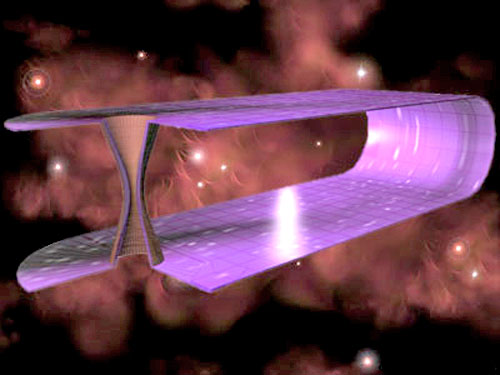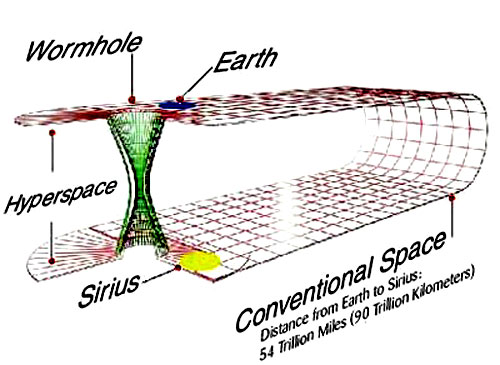Wormholes
Thorne believes there could be another type of tunnel-like structure existing in the universe that could be used for a time travel portal. Wormholes, also called Einstein-Rosen Bridges, are considered to have the most potential for time travel if they do exist. Not only could they allow us to travel through time, they could allow us to travel many light-years from Earth in only a fraction of the amount of time that it would take us with conventional space travel methods.
Wormholes are considered possible based on Einstein's theory of relativity, which states that any mass curves spacetime. To understand this curvature, think about two people holding a bed sheet up and stretching that sheet tight. If one person were to place a baseball on the bed sheet, the weight of the baseball would roll to the middle of the sheet and cause the sheet to curve at that point.
Now, if a marble were placed on the edge of the same bed sheet it would travel toward the baseball because of the curve.

Imagining space as a curved, two-dimensional plane,
wormholes like this could be formed by two masses applying enough force on spacetime
to create a tunnel connecting distant points in the universe.
In this example, space is depicted as a two-dimensional plane rather than the four dimensions that actually make up spacetime. Imagine that this sheet is folded over, leaving a space between the top and bottom. Placing the baseball on the top side will cause a curvature to form. If an equal mass were placed on the bottom part of the sheet at a point that corresponds with the location of the baseball on the top, the second mass would eventually meet with the baseball. This is similar to how wormholes might form.
In space, masses that place pressure on different parts of the universe could eventually come together to form a tunnel -- this is a wormhole. We could then travel from Earth to another galaxy and back relatively quickly (within a lifetime). For instance, let's picture a scenario in which we would want to travel to Sirius, a star that's seen in the Canis Major constellation just below Orion.
Sirius is about 9 light-years from Earth, which is about 54 trillion miles (90 trillion km).
Obviously, this distance would be far too great for space travelers to traverse and return in time to tell us about what they saw there. So far, the farthest people have traveled into space is to the moon, which is only about 248,548 miles (about 400,000 km) away from Earth. If we could find a wormhole that connected us to the space around Sirius, then we could cut the time considerably by avoiding the trillions of miles that we would have to cross with traditional space travel.
So how does all of this relate to time travel? We'll find out in the next section.
Cosmic Strings
Yet another theory for how we might travel back and forth through time uses the idea of cosmic strings, proposed by Princeton physicist J. Richard Gott in 1991. These are - as their name suggests - string-like objects that some scientists believe were formed in the early universe. These strings may line the entire length of the universe and are under immense pressure - millions upon millions of tons.
These cosmic strings, which are thinner than an atom, would generate an enormous amount of gravitational pull on any objects that pass near them.
Objects attached to a cosmic string could travel at incredible speeds, and because their gravitational force distorts spacetime, they could be used for time travel. By pulling two cosmic strings close together, or one string close to a black hole, it might be possible to warp spacetime enough to create closed time-like curves.
A spacecraft could be turned into a time machine by using the gravity produced by the two cosmic strings, or the string and black hole, to propel itself into the past. To do this, it would loop around the cosmic strings. However, there is still much speculation as to whether these strings exist, and if they do, in what form. Gott himself said that in order to travel back in time even one year, it would take a loop of string that contained half the mass-energy of an entire galaxy.
And, as with any time machine, you couldn't go back farther than the point at which the time machine was created.
Time Travel Physics
As we discussed earlier, the theory of relativity states that as the velocity of an object nears the speed of light, time slows down. Scientists have discovered that even at the speeds of the space shuttle, astronauts can travel a few nanoseconds into the future. To understand this, picture two people, person A and person B. Person A stays on Earth, while person B takes off in a spacecraft.
At takeoff, their watches are in perfect sync. The closer person B's spacecraft travels to the speed of light, the slower time will pass for person B (relative to person A). If person B travels for just a few hours at 50 percent the speed of light and returns to Earth, it will be obvious to both people that person A has aged much faster than person B.
This difference in aging is because time passed much faster for person A than person B, who was traveling closer to the speed of light. Many years might have passed for person A, while person B experienced a time lapse of just a few hours. Find out more about this twin paradox in How Special Relativity Works.

Wormholes could allow you to travel into the past and the future.
If wormholes could be discovered, it might allow us to travel to the past as well as the future. Here's how it would work: Let's say the mouth of the wormhole is portable. Then person B in the example above, who traveled at 50 percent of light speed into space for a few hours, could carry one wormhole mouth into space, while the mouth at the opposite end of the wormhole would stay with person A on Earth.
The two people would continue to see one another as person B traveled into space. When person B returned to Earth a few hours later, a few years may have passed for person A. Now, when person A looks through the wormhole that traveled into space, that person will see him or herself at a younger age, the age he or she was when person B launched into space.
The cool thing about it is that the older person A would be able to step into the past by entering the wormhole, while the younger person B could step into the future.
Problems with Time Travel
If we are ever able to develop a workable theory for time travel, we would open up the ability to create very complicated problems called paradoxes. A paradox is defined as something that contradicts itself.
Here are two common examples:
-
Let's say, for the sake of argument, that you could travel back to a time before you were born. The mere fact that you could exist in a time before you were born creates a paradox. If you were born in 1960, how could you exist in 1955?
-
Possibly the most famous paradox is the grandfather paradox. What would happen if a time traveler went back and killed one of his or her ancestors before the traveler was born? If the person killed his or her grandfather, then how could that person be alive to go back and kill his or her grandfather? If we could change the past, it would create an infinite number of paradoxes.
Another theory regarding time travel brings up the idea of parallel universes, or alternative histories. Let's say that you do travel back to meet your grandfather when he was a boy. In the theory of parallel universes, you may have traveled to another universe, one that is similar to ours, but has a different succession of events.
For instance, if you were to travel back in time and kill one of your ancestors, you've only killed that person in one universe, which is no longer the universe that you exist in. And if you then try to travel back to your own time, you may end up in another parallel universe and never be able to get back to the universe you started in.
The idea here is that every action causes the creation of a new universe, and that there are an infinite number of universes that exist. When you killed your ancestor, you created a new universe, a universe that was identical to your own up until the time you changed the original succession of events.
Confused yet?
Welcome to the world of time travel. Just imagine how complicated the ticket prices will be.

